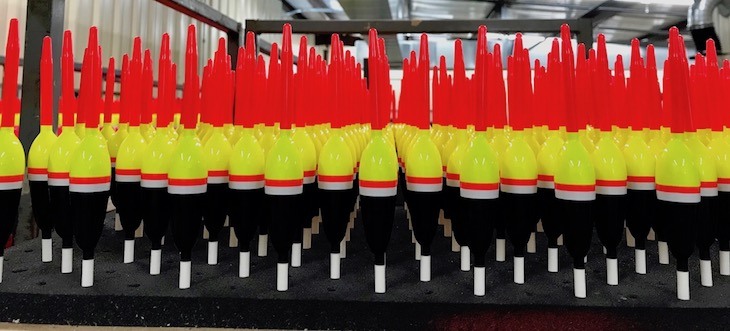EBSCO Chairman discusses employer challenges, celebrates opening of new PRADCO line
by August 16, 2018 5:49 pm 823 views

PRADCO Outdoor Brands moved its Thill production line to Fort Smith.
PRADCO Outdoor Brands celebrated Thursday (Aug. 16) the grand opening of its Thill balsam floats line, which opened three weeks ago at the new building adjacent to the existing manufacturing facility on Jenny Lind Road.
EBSCO Industries, Inc., purchased the Fort Smith-based manufacturer in 1980 and in 2016 began negotiations to add the Thill line from an acquisition in Minnesota. The line resulted in the addition of 25 new jobs, all part of the 60 announced last November at a ceremony attended by Arkansas Gov. Asa Hutchinson.
To help celebrate Thursday’s opening, EBSCO Chairman Bryson Stephens spoke to a crowd of more than 200 about the decision to move Thill to Fort Smith and continue manufacturing in the city for the foreseeable future, challenging his team to always be seeking perfection, “so you’ll find excellence” along the way, referencing a quote from former Green Bay Packers Coach Vince Lombardi.
Before the ceremony, Stephens complimented the quality of the Fort Smith workforce to Talk Business & Politics, calling them “as good as it is anywhere in the United States.” The company’s biggest challenge from a workforce standpoint, he said, is continuing to recruit talent.
“What we’re experiencing here — and I believe Fort Smith’s unemployment rate is running at about 3.5% — is a healthy economy. So people have options, and they will move for a better opportunity, to find better pay or maybe a job that’s closer to home or a job that has better benefits. So we have to be an attractive place to work because there’s not a line out the door of people wanting positions. We have to search for them and work to earn their trust and bring them on board, and then we have to work to retain them after that.”
Stephens said PRADCO looks for a mix of “skills and personality,” adding that on the skills side, “there are certainly jobs here — like in our tool room where they’re running CNC machines — where they need to have either a depth of experience or an education in how to program a CNC machine and how to run it safely and efficiently. And for some of our less-skilled positions, it’s important we get the right personalities — people with good personalities, who can be flexible, who are good team members. It’s really a mix.”
Continuing education is a piece of that, Stephens said.
“The team here — they’re constantly trying to inventory our talent and support those who want to advance, learn skills and move around. It’s much easier to give an opportunity to somebody who’s already on your team than to go out and hire someone you’ve never met before. We love cross-training and providing people with opportunities to grow within the business.”
Stephens said PRADCO, like other manufacturers, is subject to certain macroeconomic trends.
“People are moving to cities, people are moving from a physical, traditionally blue-collar manufacturing/agricultural-type job to more of an office/service-type job. That trend has been going on for decades, and I think it continues to some degree.”
PRADCO, Stephens said, battles against the longstanding, mostly U.S.-based mindset that manufacturing jobs are unattractive.
“We battle that perception that manufacturers’ jobs are less attractive or on the lower end of the scale. But we have people who have been here 20 years who’ve worked their way up from entry-level position and they’re now a supervisor of a department, and they’re making good money.”
Stephens commended state and local efforts to bring manufacturing more into the classrooms, stating that “it’s something we need to continue to work at because we do need to keep that pipeline full of applicants.”
Despite the challenges of finding talent in a healthy economy, PRADCO has grown steadily in the last year and a half, going from 94 employed to the current 196. They’ve done so partially through social media, raising their brand identity from 0-2 million in just under three years. The $50-60 million investment announced in November 2017 has a final jobs target of 290.
